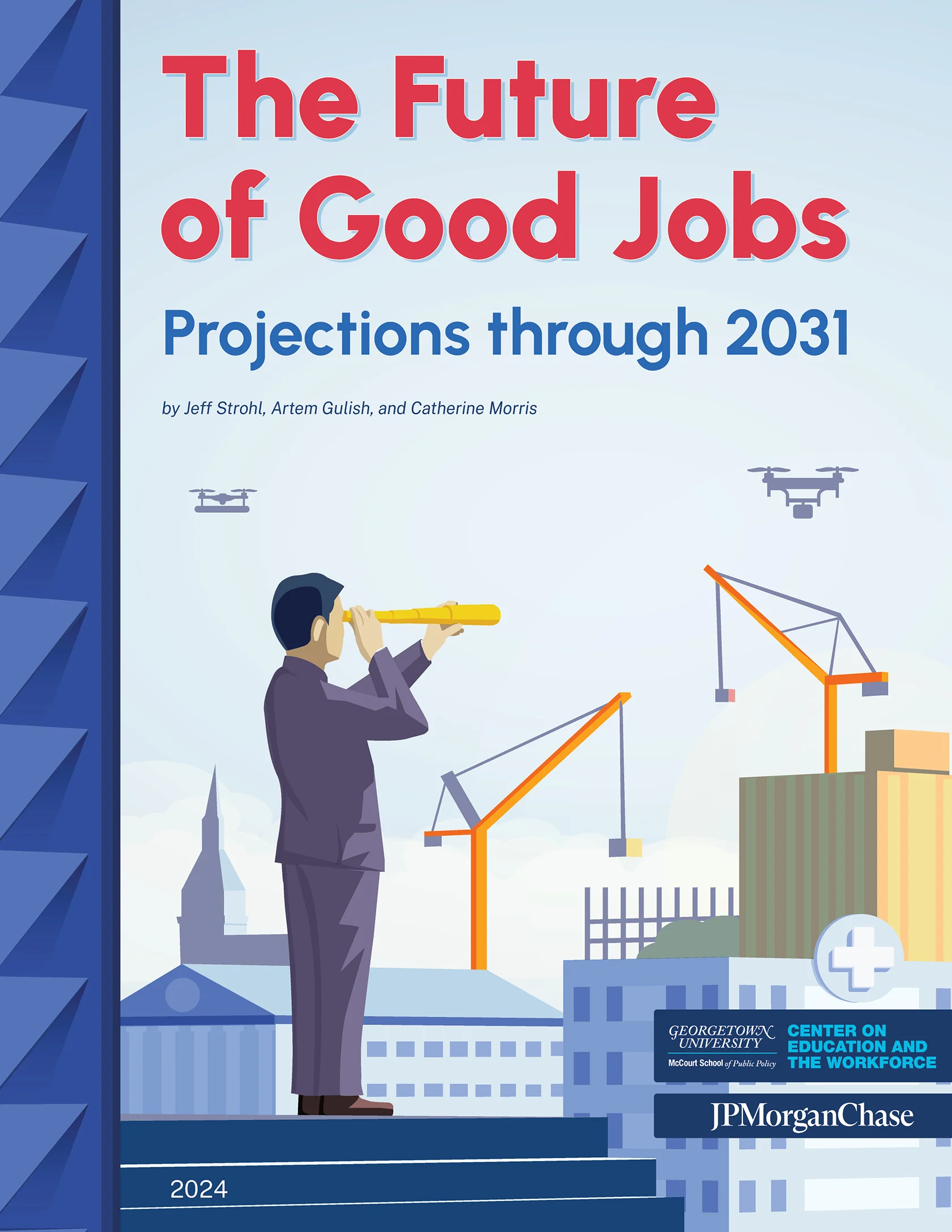Summary
Even against a backdrop of economic uncertainty—driven by high inflation and interest rates, generative AI, international conflicts, changing demographics, and a shifting policy environment—the future of good jobs in the US looks promising. Economic opportunity will increasingly favor workers with higher levels of education and training.
The Future of Good Jobs: Projections through 2031 forecasts the number of good jobs in 2031 for workers ages 25–64 by 22 occupational groups and three educational pathways (bachelor’s degree, middle skills, and high school). The report finds that while there will be good jobs on every educational pathway in 2031, only 15 percent will be available to workers on the high school pathway, compared to 66 percent on the bachelor’s degree pathway and 19 percent on the middle-skills pathway.
Source: Georgetown University Center on Education and the Workforce projections using Carnevale et al., After Everything, 2023; US Census Bureau and Bureau of Labor Statistics, Current Population Survey (CPS), March Supplement, 1992–2020; and US Bureau of Economic Analysis, SARPP Regional Price Parities by State, 2020.
Note: Values may not sum to 100 percent due to rounding. The minimum earnings threshold for good jobs is adjusted for the difference in cost of living by state and for inflation to 2020 dollars using R-CPI-U-RS.
Good Jobs and Promising Occupations
– What Is a Good Job?
CEW defines a good job as one that pays, nationally, a minimum of $43,000 to workers ages 25–44 and a minimum of $55,000 to workers ages 45–64, with a median of $82,000 for all good jobs.
– What is a Promising Occupation?
To help workers make decisions that maximize their likelihood of securing a good job, this report introduces the concept of promising occupations for workers on each educational pathway. To be considered promising, an occupational group must meet two criteria:
- More than half of jobs in the occupational group are projected to be good for workers on a given educational pathway in 2031.
- The occupational group will employ a higher share of workers on a specific educational pathway than will the overall economy in 2031 (more than 52 percent for workers on the bachelor’s degree pathway, 22 percent on the middle-skills pathway, and 26 percent on the high school pathway).
Good Jobs and Promising Occupations on Each Educational Pathway
Occupational Cluster
Managerial and professional office
STEM
Education, training, and library
Community services and the arts
Healthcare professional and technical
Healthcare support
Food and personal services
Sales and office support
Blue-collar
Both upskilling within occupations and growth of occupations that require comparatively high levels of education will increasingly shift opportunity to workers with bachelor’s degrees or higher. As a result, the bachelor’s degree pathway will offer the largest number of good jobs (58.2 million) and promising occupational groups (10) in 2031.
Occupational Cluster
Managerial and professional office
STEM
Education, training, and library
Community services and the arts
Healthcare professional and technical
Healthcare support
Food and personal services
Sales and office support
Blue-collar
Federal investments in infrastructure, along with slower labor force growth, fewer college graduates, and expanding generative AI capabilities, have the potential to support a more robust middle-skills labor market than in previous decades. By 2031, middle-skills workers will have 16.4 million good jobs and five promising occupational groups available to them.
Occupational Cluster
Managerial and professional office
STEM
Education, training, and library
Community services and the arts
Healthcare professional and technical
Healthcare support
Food and personal services
Sales and office support
Blue-collar
Ten of the 22 occupational groups will see net declines in good jobs on the high school pathway, even as many of these same occupations will see growth in the numbers of good jobs on the bachelor’s degree and middle-skills pathways. Consequently, by 2031, the high school pathway will only have 13.2 million good jobs available to workers and just one promising occupational group (installation, maintenance, and repair).
Resources
The Future of Good Jobs: Projections through 2031 forecasts that the bachelor’s degree pathway will be the dominant route to good jobs in the future despite continued skepticism about the value of a college degree.

